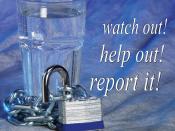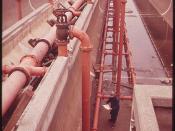Historically societies have flourished when developed around major waterways such as rivers, lakes, streams, and ocean. This resource can be used as transportation routes, source of irrigation for agriculture and livestock or as drinking water. Drinking water is a natural resource which has become scarce in certain places on the globe and its availability and quality are a source of social and economic concern.
Drinking water that is safe for human consumption is called "potable water". In today's world potable water is collected from many of the same sources as in the ancient or even the prehistoric world; artesian springs, wells, rainfall, rivers, and lakes are a few common sources. The methods of extraction and utilization have changed through the years to meet demand and prevent contamination and waste. Water which is extracted from these resources must be purified for human consumption.
Currently there are many different methods used to remove un-dissolved material, dissolved substances, and harmful microbes.
Artificial boring, waste water management and recycling, pollutant and contaminate extraction, fluoridation and purification are all methods used in today's journey to obtain potable water. Water pollution is a serious problem in many countries where poor purification techniques and contaminated land are just a few sources of polluted water. Contaminated water has accounted for more than 14,000 deaths daily (water pollution, 1986).
In America Distribution of drinking water is done through public water systems or as bottled water marketed by private companies. These agencies and companies are controlled by the passage of the Clean Water Act of 1977 (Water pollution, 1986). However even when the Clean Water Act of 1977 is considered and enforced there is still the likelihood of an introduction of contaminates into potable water systems. This act was designed to implement wastewater standards for the industry. There were also...


